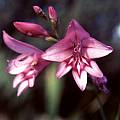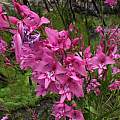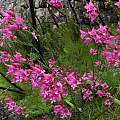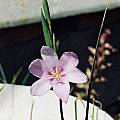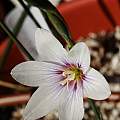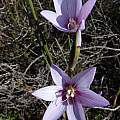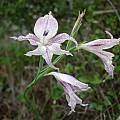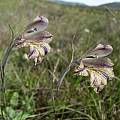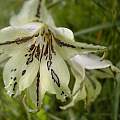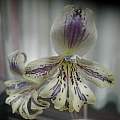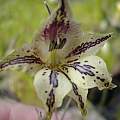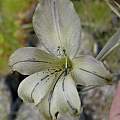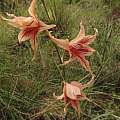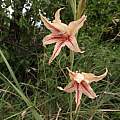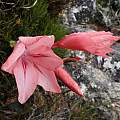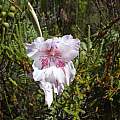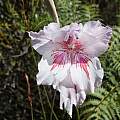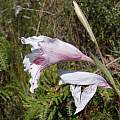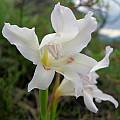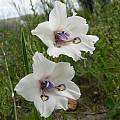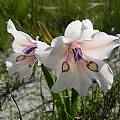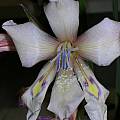From pale rose and mauve to salmon to screaming pink, this color complex offers many shades and the widest range of species in the color indices.
Page 1: G. anatolicus... Page 2: G. carmineus... Page 3: G. densiflorus... Page 4: G. gracilis... Page 5: G. maculatus... Page 6: G. nigromontanus... Page 8: G. saxatilis... Page 9: G. vernus...
Gladiolus phoenix Goldblatt & J.C.Manning is a rare local endemic restricted to moist backs and ravines in the Bain's Kloof Mountains. This plant appears to need fire to stimulate bloom. Flowers are pink with a white spear shaped mark outlined in deep pink on the lower three tepals. The first photo by Alan Horstmann. The next two were taken by Rachel Saunders post fire near Bainskloof, November 2015.
Gladiolus quadrangulus (D.Delaroche) Barnard (syn. Ixia linearis, G. linearis, G. biflorus) is found in the southwestern Cape in sandy soil in seasonally wet, poorly drained and sometimes brackish habitat. Goldblatt & Manning report that it has been eliminated from most of its original range, and that "its long-term survival in the wild is unlikely." Fortunately, it is relatively easy to grow in cultivation, where it can be treated like a typical winter-growing Glad. It has pale pink, mauve or white flowers. The tepals have darker veins. It blooms late winter into spring. The shape of the flowers is reminiscent of an Ixia, and unlike most Gladiolus it does not produce nectar. Goldblatt & Manning speculate that it is adapted to pollination by pollen-eating insects. First photo by Alan Horstmann. Second photo by Michael Mace of a plant whose name tag was lost, but which is almost certainly G. quadrangulus. The final photo was taken by Rachel Saunders who photographed it in the wild.
Gladiolus recurvus Linnaeus occurs in shale derived soils from Ceres to Bredasdorp and flowers from June to October depending on the elevation. The fragrant flowers are pale gray to cream, yellowish or pinkish with purple lines and dots on the lower tepals and sometimes spotted or lined in the midline on the upper tepals as well. The first two photos were taken by Cameron McMaster in the Overberg. The other photos by Dirk Wallace show variation in the markings on flowers.
Gladiolus reginae Goldblatt & J.C.Manning is a rare species known from only two populations where plants grow in open woodland in rocky outcrops, partially shaded by shrubs and trees, in heavy metal-enriched soils. Growing from .4 to 1.5 m, it has 7 to 16 unscented long tubed flowers in an erect spike. Flowers are pale flesh-pink flushed deeper salmon and the lower three tepals are flushed deep red in the basal third with longitudinal lines. The upper three tepals are flushed deep red at the base. Flowering takes place from mid March to mid April, but may skip a year if it's too dry. Goldblatt and Manning report that flowers are pollinated by long-proboscid flies, but also attract ants with sweet droplets from the tips of the bracts, likely for protection from other insects.
Photos by Rachel Saunders shows specimens found in the Blyde River Canyon Nature Reserve (situated in Mpumalanga).
Gladiolus rhodanthus J.C. Manning & Goldblatt is distributed on rocky sandstone slopes at high elevations in the southwest Cape. Growing from 30 to 50 cm, it has hairy linear leaves and pink flowers with red markings on the lower tepals. Photo by Rachel Saunders taken with some effort since it was quite a climb (in light rain/mist) to get to it. It was growing at 1700 m in cracks in the cliffs.
Gladiolus roseovenosus Goldblatt & Manning is a rare winter rainfall species that grows in peaty sandstone soil on well drained slopes in the coastal foothills of the Outeniqua Mountains in the southern Cape. Plants grow 20 to 40 cm high and the long tubed creamy pink unscented flowers with red nectar guides are in a 2 to 4 flowered spike. Blooming time is summer into fall, between February and April. Photos taken by Rachel Saunders.
Gladiolus rudis Licht. ex Roem. & Schult. grows on sandstone slopes in fynbos in the southwestern Cape and blooms in spring. It has 2 to 5 cream to pale pink flowers on a spike. The lower tepals have spear-shaped markings and the perianth tube is funnel shaped. The first three photos taken by Cameron McMaster near Caledon and Fairfield in the Overberg and the last taken by Alan Horstmann.
Gladiolus salteri G.J.Lewis is a winter-grower found in a small area of granite hills in Namaqualand. It has thin pink tepals, with red and cream chevrons on the lower ones, and is believed to be pollinated by long-tongued bees. You can see a photo of it here.
Page 1: G. anatolicus... Page 2: G. carmineus... Page 3: G. densiflorus... Page 4: G. gracilis... Page 5: G. maculatus... Page 6: G. nigromontanus... Page 8: G. saxatilis... Page 9: G. vernus...
